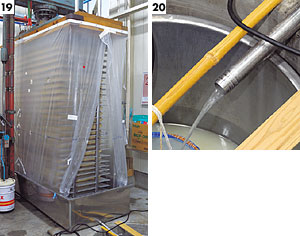Special Feature![]() Here’s to Japanese sake!
Here’s to Japanese sake!
The Long Journey from Polishing to Bottling

Starter mash is prepared in a tub. The starter mash is made in a room (13) that is quite cool, about 5 °C. That’s much cooler than where the koji mold is made. Only the strongest and most effective yeast microorganisms will survive at this temperature. Koji mold, water, lactic acid (to destroy harmful bacteria), kobo yeast, and some steamed rice are mixed together (14), then set aside for about 16 days to let the yeast propagate and the mixture ferment (15).

Koji mold, water and some steamed rice are added to the starter mash (16, 17). This energizes the yeast microorganisms. To keep them active, the koji mold, rice and water are added in small, separate batches, three times for each. The koji mold transforms the rice into glucose, which is acted upon by the yeast to make alcohol. During this time, thousands of bubbles of carbonic acid gas rise to the surface (18), giving off a sweet, fruity smell. The fermentation stops about 20 days later. What remains is the moromi mash and an alcoholic brew.

When the moromi is pressed, out comes the sake. At this brewery, the pressing is done the old-fashioned way, stuffing the moromi in bags, placing them on top of each other, and leaving them like that for one full day to press the sake out (19, 20). The liquid is strained to remove small bits of rice and other particles that make it cloudy. Then it is filtered, pasteurized, bottled and stored.